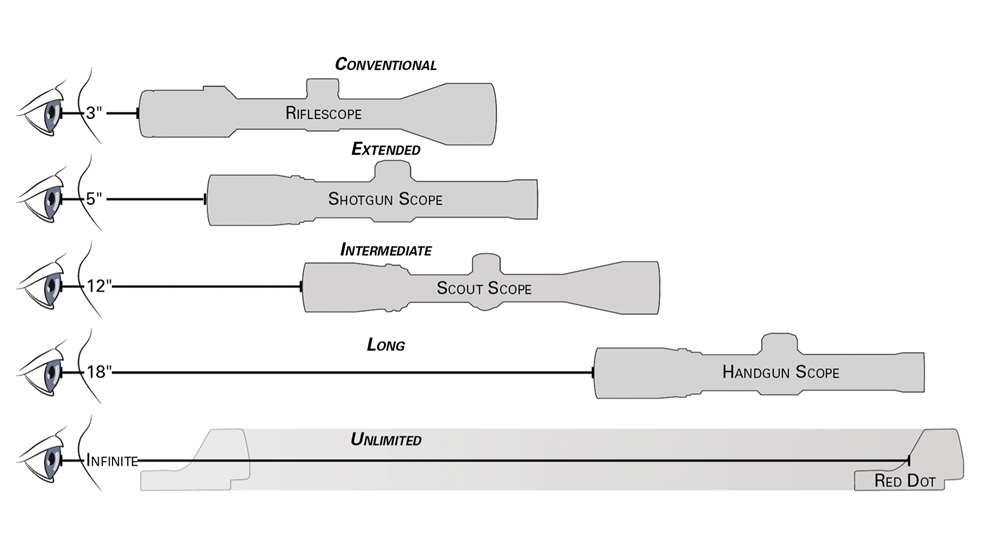
Q. I’m trying to understand the term “eye relief” with regard to rifle and pistol scopes. I know it can vary depending on the optic’s application, but what is an appropriate, or acceptable, amount and why is it important?
A. Your question is a good one, and, as is often the case with such inquiries, requires the use of a few terms specific to the topic, shown in quotes below, to answer it properly. Essentially, “eye relief” is the distance from the rearmost surface of the ocular lens, or eyepiece, to the front of the user’s eye. It is one characteristic of riflescope design wherein the “exit pupil” of the transmitted light produces an image that fills the entire “eyebox,” or viewable area, with no “vignetting,” or darkening at the edges, resulting in a full “field of view,” which is the observable area at a given distance. In general, the higher the scope’s magnification, and the smaller its field of view, the shorter its eye relief.
A scope conveys its image to the viewer’s eye in rays of light that are projected as a “cone” whose diameter can be measured. The average human eye pupil measures around 4 mm in daylight and can dilate to as much as 8 mm in dark conditions. So, an exit pupil of light measuring more than that under such conditions is somewhat “wasted”; conversely, one measuring less will not provide a complete image in the eyepiece. The formula for determining the exit pupil size of a scope is simple: divide the diameter of its objective lens by its magnification. For example, a fixed 10X scope with a 50 mm diameter objective lens will result in a 5 mm exit cone.
Riflescopes are designed to provide a particular amount of eye relief, depending on their intended use, and can be divided into four main categories: “Conventional” riflescopes are intended for mounting atop the receiver of a full-stocked long gun and typically offer, on average, about 3" of eye relief. Of course, some can exhibit much less—older models intended for rimfire use may offer as little as 1" of eye relief. The next category has been referred to as “extended” and may range from about 4.5" to 6.5" of eye relief. Such designs have been marketed to muzzleloaders and shotgunners seeking additional clearance between their faces and scopes mounted on guns whose recoil impulse can be pronounced.
Then there are “intermediate” eye-relief scopes—perhaps best typified by scopes intended for use on “scout” rifles—and they are designed to be mounted mostly forward of a rifle’s receiver over the rear end of the barrel. Typically, they range from 2X to 7X in magnification and exhibit from about 9" to 15" of eye relief. Yet another category is “long” eye-relief scopes, which, as might be expected, are for use on handguns held at arms’ length. Their eye relief can range from 15" to 21". Finally, it’s worth mentioning that most reflex or “red-dot” sights, because of the nature of their design, are considered to have “non-critical” or “unlimited” eye relief. They can be mounted as close to, or as far away from, the shooter’s face as desired and still render their aiming points with acceptable clarity and sharpness.
Note that the figures quoted for each range of eye relief are approximate. I have found that some manufacturer product descriptions fail to accurately denote actual eye relief. I have also seen the misapplication of terminology in specific cases, with at least one manufacturer appending the “scout” label to scopes that actually work only in the conventional position. Also, some scopes marketed for use in intermediate-eye-relief rifle applications are nearly identical, optically and mechanically, to models sold for handgun applications and can be used interchangeably.
Vague nomenclature notwithstanding, the practical reasons that eye relief is important include the fact that it can be a safety consideration. Experienced shooters know that if eye relief is too short for a scope mounted on a hard-recoiling rifle or shotgun, the dreaded phenomenon of “scope eye” can occur wherein the optic strikes the user’s orbital ridge as the firearm moves quickly rearward under recoil. It is, at the least, embarrassing when shooting with others, and, at worst, injurious to the shooter’s face—yet another reason protective eyewear is essential when shooting. Second, matching a scope with the appropriate eye relief to a firearm intended for a particular use ensures that the shooter will derive optimum benefit from the outfit as a whole.




































